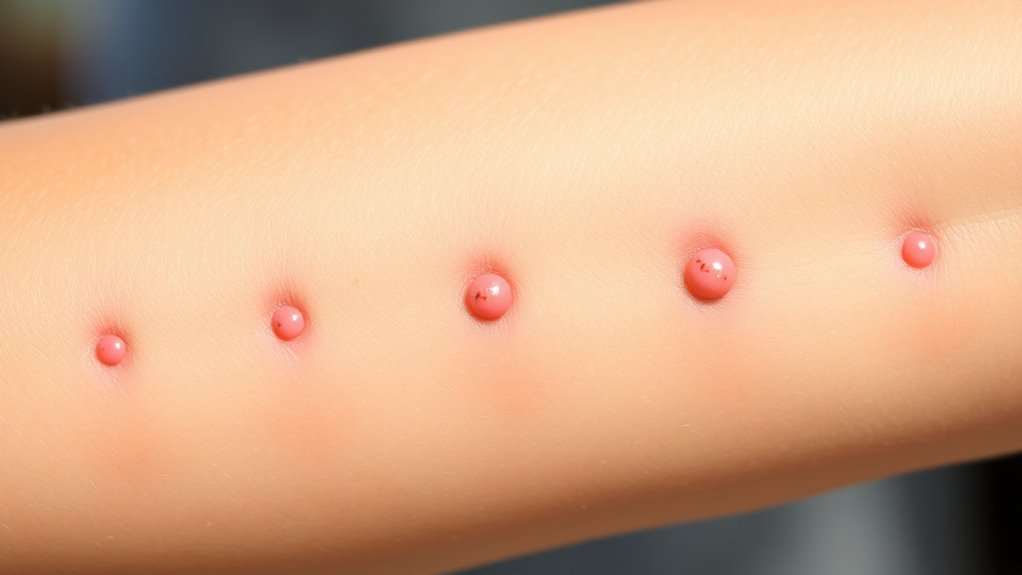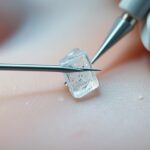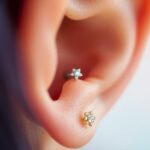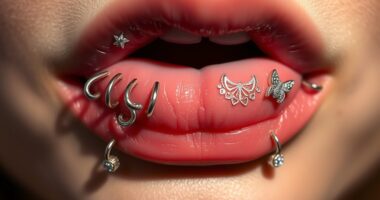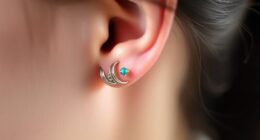When you get pierced, you’ll likely feel a quick, sharp pinch or sting that lasts just moments, with cartilage piercings often more painful than lobe ones. Afterward, you might notice dull ache, pressure, or throbbing that varies based on the piercing spot. During healing, tenderness and mild discomfort are common, but severe pain or signs of infection should be addressed. If you keep exploring, you’ll discover more about managing pain and caring for your piercing.
Key Takeaways
- Piercing pain begins with a quick, sharp needle prick, varying slightly based on individual sensitivity.
- Cartilage piercings generally cause more pain than earlobe piercings during insertion.
- Post-piercing discomfort may include dull ache, throbbing, or pressure, and lasts from hours to days.
- During healing, sensations like tenderness, itching, or mild burning are common and gradually subside.
- Severe, persistent pain or signs of infection require medical attention to prevent complications.

Getting a piercing can be nerve-wracking, especially if you’re worried about pain. The idea of a needle going through your skin can trigger anxiety, but understanding what to expect can help ease those nerves. When the needle pierces your skin, you’ll likely feel a quick, sharp sensation—this is the needle sensation that many describe as a sudden pinch or sting. For most piercings, this feeling lasts just a moment before subsiding. After the initial pinch, some people notice a dull ache or pressure, but it’s usually manageable. Kiss Me Knowing what to expect can also reduce anxiety and make the experience more comfortable. Once the needle has passed through, there’s often a brief moment of throbbing or pulsating pain. This sensation can vary depending on the location and your pain threshold. For example, cartilage piercings tend to be more painful than lobe piercings due to the density of the tissue. It’s important to remember that pain levels differ from person to person, and what’s intense for one individual may be mild for another. After the piercing, you’ll experience some healing discomfort. This isn’t necessarily pain but rather a sensation of tenderness and soreness that lasts for a few days to a week. The healing discomfort is most noticeable when you touch or accidentally bump the area. During this time, your body is working to heal the tiny wound, which can cause mild swelling, redness, or sensitivity. To manage this, follow your piercer’s aftercare instructions closely. Avoid touching or twisting the jewelry unnecessarily, and keep the area clean to prevent infection. It’s also common to experience some itching or a slight burning feeling as the piercing heals. These sensations are part of the natural healing process and should gradually fade. If you notice persistent, severe pain or signs of infection—such as excessive swelling, pus, or warmth—seek professional advice promptly. Remember, some discomfort during healing is normal, but it shouldn’t be overwhelming or persistent.
Frequently Asked Questions
How Long Does Pain Typically Last After a Piercing?
Pain typically lasts a few hours to a few days after getting a piercing, depending on the piercing type and your healing timeline. You can manage discomfort with ice, over-the-counter pain relief, and proper cleaning. Remember, everyone’s healing process is different, so stay attentive to your body’s signals. If pain persists or worsens, consult your piercer or a healthcare professional for tailored pain management techniques.
Are There Pain Differences Between Cartilage and Lobe Piercings?
Think of cartilage and lobe piercings as different musical notes—one sharp and resilient, the other smooth and mellow. You’ll likely find cartilage piercings more intense, like striking a drum, because they involve thicker tissue. Lobe piercings tend to be gentler, like a soft melody. Expect some discomfort with cartilage piercings, but it usually lasts longer, while lobe piercings are quicker to settle down.
Does Pain Vary With Different Jewelry Materials?
Yes, pain can vary with different jewelry materials. If you have material sensitivity, certain metals may cause discomfort or allergic reactions, affecting your overall jewelry comfort. For example, hypoallergenic options like surgical steel or titanium tend to be more comfortable and reduce pain during healing. Choosing the right material helps minimize irritation, making your piercing experience smoother and less painful. Always opt for high-quality jewelry to enhance comfort and avoid complications.
Can Pain Be Minimized With Numbing Creams?
Using numbing creams can drastically reduce your pain, making it feel like a gentle tap instead of a lightning strike. They’re a smart choice for pain management, especially if you’re nervous about piercings. Apply the cream as directed, and it’ll numb the area enough to make the process more comfortable. Just remember, results vary, so combining creams with other calming techniques can give you the best experience.
Are There Age-Related Pain Differences in Piercings?
You may notice age-related pain differences in piercings, as younger skin tends to be more sensitive, but your experience also depends on piercing techniques and cultural perceptions. Older individuals might feel less pain due to thicker skin or familiarity with the process, while cultural perceptions can influence how you perceive discomfort. Choosing a skilled piercer and discussing your concerns helps guarantee a smoother experience regardless of age.
Conclusion
Knowing what to expect can ease your piercing experience. Remember, most piercings fall within a moderate pain range, with some types like nostril piercings ranking lower on the pain scale. notably, a recent survey found that over 70% of people report only mild discomfort during their piercings. So, don’t let fear hold you back—trust your piercer and know that the pain is temporary, leading to a stylish new look you’ll love.

